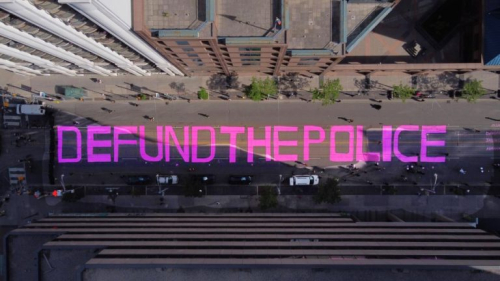Demonstrations that followed the death of George Floyd attracted due attention to anti-Black racism in the US and many other countries. Throughout the events, people from various socio-political and cultural backgrounds gained representation and visibility out on the streets, voicing their discontent with the mistreatment of underprivileged citizens. Their physical presence, refusing systematic exclusion in the cities, loudly pronounced that the state instruments do not have ultimate domination over public space. Ordinary people can reverse the power of authorities by producing space through their experience and imagination. Racial justice protests provide new perspectives to the study of public space because they can make the invisible of injustice visible and break spatial inequalities by transforming cities' segregated landscapes. The readings curated for this session highlight the role of public space in civil protests. As a set, they provide insights into how citizen and community-driven interventions—related to protest events—could change the ways we perceive, use, and (re)make public space and address the role of race in spatial production.
The two journalism pieces by Julia Jacobs and Sarah Ratzlaff examine street art practices in the US and Canada that emerged during the recent protests against anti-Black racism. Jacobs’ article focuses on the two Black Lives Matter (BLM) scripts painted in Harlem and at Foley Square, Lower Manhattan.1 Ratzlaff’s interview with the artist and activist Syrus Marcus Ware addresses various urban interventions that spread in Toronto around the same time.2 Both sources reveal that the artistic components of the BLM movement intended to convey political messages to authorities. For instance, the protestors strategically placed some of the BLM scripts near the White House and Trump Tower. Similarly, the “Defund the Police” mural outside the Toronto Police Service headquarters underscored the Black citizens who fell victim to police brutality. In those cases, the placement challenged the representative character of space by making a statement against the political power and economic structure that capacitated systematic racial oppression. The murals inserted Black citizens’ presence into the city to address a wider public outside the boundaries of segregated districts. Besides, the artists and designers found opportunities to reflect on the struggles of discriminated communities in public space. Despite being regarded as symbolic gestures initially, these practices opened up transparent conversations on race, policing, and social inequalities.3 They also became gathering places with symbolic meaning (re)created by the citizens’ collective efforts and embodied experiences.
This week’s readings underscored that racial justice protests contribute to public processes in terms of making “possible futures and alternative social structures” visible.4 In parallel, the discussions pointed at architects’ intellectual and professional agency in responding to systemic racism and spatial injustice. How could we use public spaces to open up dialogues on racial injustice? What role could architects undertake to that end? The transformation of everyday experiences to politicized experiences increases excluded groups’ participation in politics and their role in spatial production. Moreover, critical ways of addressing people’s “right to the city” can provoke egalitarian spatial structuring initiatives in the long-term. Using their design skills and activist agency in protest, architects can raise awareness of racial injustice, create more inclusive public spaces, and influence policy changes to promote discriminated citizens’ equal participation in urban life.


————————–
1 Julia Jacobs, “The ‘Black Lives Matter’ Street Art That Contains Multitudes,” New York Times, July 16, 2020. https://www.nytimes.com/2020/07/16/arts/design/black-lives-matter-murals.... 2
Sarah Ratzlaff, “The Connections between Public Art and Activism,” Spacing Toronto (blog), July 22, 2020. http://spacing.ca/toronto/2020/07/22/the-connections-between-public-art-....
3 Ibid.
4 Ratzlaff, “The Connections between Public Art and Activism.”

